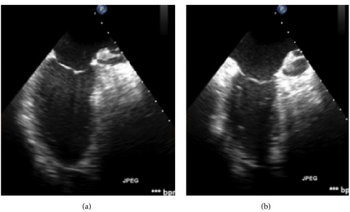Myocardial stunning
| Myocardial stunning | |
|---|---|
| Other names: transient post-ischemic myocardial dysfunction[1] | |
| Complications | Takotsubo cardiomyopathy |
| Differential diagnosis | hibernating myocardium, silent ischemia, myocardial infarction, acute pericarditis, myocarditis, pulmonary embolism |
Myocardial stunning or transient post-ischemic myocardial dysfunction is a state of mechanical cardiac dysfunction that can occur in a portion of myocardium without necrosis after a brief interruption in perfusion, despite the timely restoration of normal coronary blood flow.[2][3] In this situation, even after ischemia has been relieved (by for instance angioplasty or coronary artery bypass surgery) and myocardial blood flow (MBF) returns to normal, myocardial function is still depressed for a variable period of time, usually days to weeks.[2][1] This reversible reduction of function of heart contraction[4] after reperfusion is not accounted for by tissue damage or reduced blood flow, but rather, its thought to represent a perfusion-contraction "mismatch".[5][2] Myocardial stunning was first described in laboratory canine experiments in the 1970s where LV wall abnormalities were observed following coronary artery occlusion and subsequent reperfusion.[6]
Signs and symptoms
Among the clinical presentation of myocardial stunning is chest pain in the affected individual[7]
Cause
Clinical situations associated with myocardial stunning include:[2]
- acute myocardial infarction (AMI) with early reperfusion
- unstable angina
- after percutaneous transluminal coronary angioplasty (PTCA)
- after cardiac surgery
- 'neurogenic' stunned myocardium following an acute cerebrovascular event such as a subarachnoid hemorrhage
- in patients undergoing chronic hemodialysis, chronic myocardial stunning may lead to heart failure
Myocardial stunning has been implicated in the development of Takotsubo (Stress) cardiomyopathy.[1]
Pathophysiology
The underlying mechanisms of myocardial stunning have remained the subject of debate for several decades.[8] Two leading hypotheses implicate reperfusion-induced oxygen free-radical damage and altered calcium flux resulting in intracellular hypercalcemia and desensitization of myofilaments.[1] After total ischemia occurs, the myocardium switches immediately from aerobic glycolysis to anaerobic glycolysis resulting in the reduced ability to produce high energy phosphates such as ATP and Creatinine Phosphate. At this point, the lack of the energy and lactate accumulation results in cessation of contraction within 60 seconds of ischemia (i.e. Vessel Occlusion). Subsequent to this is a period of "myocardial stunning," in which reversible ischemic damage is taking place. At approximately 30 minutes after the onset of total ischemia the damage becomes irreversible,[6] thereby ending the phase of myocardial stunning. The generation of oxygen-derived [free radicals] during the initial period of reperfusion after ischemia is believed to contribute to the pathogenesis of myocardial stunning.[8]
Some evidence suggests that brief, repetitive episodes of myocardial ischemia may result in chronic myocardial stunning and ventricular contractile impairment.[1]
Diagnosis

Imaging techniques such as echocardiography, ventriculography, and nuclear imaging can be used to detect a contractile dysfunction following reperfusion after an episode of ischemia.[1] The area of dysfunction should also maintain normal perfusion, detected via Positron Emission Tomography, echocardiography with contrast, and/or thallium scintigraphy in order for a diagnosis of myocardial stunning to be considered.[1] However, there are many practical challenges to diagnosing myocardial stunning using these methods. Accurate detection of regional myocardial blood flow and contraction function abnormalities must be detected at levels of high sensitivity.[2] The diagnosis of myocardial stunning must also be differentiated from other conditions such as hibernating myocardium and persistent (silent) subendocardial ischemia, which can also co-exist with superimposed stunning.[2]
Management
Treatment considerations for myocardial stunning should be determined based on the clinical judgment of the cardiologist or physician, the degree of LV impairment and symptoms, and the wishes of the person.[6]
Some evidence supports the use of inotropic drugs in the case of severe myocardial dysfunction.[9]
Results from canine experimental trials investigating the oxygen free-radical hypothesis for myocardial stunning have shown a reduction in free radical generation and improvement in myocardial function following anti-oxidant infusion.[6][10]
References
- ↑ 1.0 1.1 1.2 1.3 1.4 1.5 1.6 Kloner R (2020). "Stunned and Hibernating Myocardium: Where are we nearly 4 decades later?". Journal of the American Heart Association. 9 (3): e015502. doi:10.1161/JAHA.119.015502. PMC 7033879. PMID 32013699.
- ↑ 2.0 2.1 2.2 2.3 2.4 2.5 Bolli R (December 1992). "Myocardial 'stunning' in man". Circulation. 86 (6): 1671–1691. doi:10.1161/01.cir.86.6.1671. PMID 1451239.
- ↑ Braunwald E (1982). "The stunned myocardium: prolonged, postischemic ventricular dysfunction". Circulation. 66 (6): 1146–1149. doi:10.1161/01.cir.66.6.1146. PMID 6754130. S2CID 6844410.
- ↑ Myocardial+Stunning at the US National Library of Medicine Medical Subject Headings (MeSH)
- ↑ Grund F (February 2001). "Three cardiac mysteries--stunning, hibernation and ischemic preconditioning". Tidsskr. Nor. Laegeforen. (in norsk). 121 (4): 440–4. PMID 11255859.
- ↑ 6.0 6.1 6.2 6.3 Vaidya Y (August 2020). "Myocardial Stunning and Hibernation". StatPearls [Internet]. PMID 30725711.
- ↑ Parajuli, Priyanka; Goyal, Amandeep (2022). "Stunned Myocardium". StatPearls. StatPearls Publishing. Archived from the original on 14 August 2022. Retrieved 14 August 2022.
- ↑ 8.0 8.1 Duncker D (June 1998). ""Myocardial stunning": remaining questions". Cardiovascular Research. 38 (3): 549–558. doi:10.1016/S0008-6363(98)00061-3. PMID 9747426.
- ↑ Przyklenk K (October 1987). "Acute effects of hydralazine and enalapril on contractile function of postischemic "stunned" myocardium". Am. J. Cardiol. 60 (10): 934–936. doi:10.1016/0002-9149(87)91059-9. PMID 2821788.
- ↑ Bolli R (Sep 1989). "Marked reduction of free radical generation and contractile dysfunction by antioxidant therapy begun at the time of reperfusion. Evidence that myocardial "stunning" is a manifestation of reperfusion injury". Circ. Res. 65 (3): 607–22. doi:10.1161/01.res.65.3.607. PMID 2548761. S2CID 449346.
Further reading
- "Myocardial “stunning” in man"
- Baker C, Rimoldi O, Camici P, Barnes E, Chacon M, Huehns T, Haskard D, Polak J, Hall R (1999). "Repetitive myocardial stunning in pigs is associated with the increased expression of inducible and constitutive nitric oxide synthases". Cardiovasc. Res. 43 (3): 685–97. doi:10.1016/S0008-6363(99)00149-2. PMID 10690340.
- Wittstein IS, Thiemann DR, Lima JA, et al. (February 2005). "Neurohumoral features of myocardial stunning due to sudden emotional stress". N. Engl. J. Med. 352 (6): 539–48. doi:10.1056/NEJMoa043046. PMID 15703419.
External links
| Classification |
|---|
